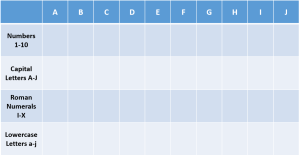Allocating costs is such a normal way of doing business these days – but for many of us, it doesn’t pass the smell test. For a long time, I couldn’t understand exactly why – then I found this article that describes it perfectly.
Watch what happens when the Cost Accountants show us that overhead should be allocated to everything – it gets reduced to the absurd…
Understanding this is one of the many reasons that the managerial accounting concept of THROUGHPUT ACCOUNTING is such a breath of fresh air…
PEANUTS — or The Higher Control of Business (Source: The New York Certified Public Accountant, June 1960.)
Joe, the restaurateur, adds a rack of peanuts to the counter, hoping to pick up a little extra profit in the unual course of business. He is interviewed by his Accountant-Efficiency Expert.
Accountant: “Joe, you said you put in these peanuts because some people ask for them, but do you realize what this
rack of peanuts is costing you?”
Joe: “It ain’t gonna cost. ‘Sgonna be a profit. Sure, I hadda pay $25 for a fancy rack to halda bags, but the peanuts
cost six cents a bag and I sell ‘em for ten cents. Figger I sell fifty bags a week to start. It’ll take twelve and a half weeks to cover the cost of the rack. After that, I getta clear profit of four cents a bag. The more I sell, the more I make!”
Accountant: “This is an antiquated and completely unrealistic approach, Joe. Fortunately, modern accounting procedures permit a more accurate picture which reveals the complexities involved.”
Joe: “Huh?”
Accountant: “To be precise, those peanuts must be integrated into your entire operation and be allocated their appropriate share of business overhead. They must share a proportionate part of your expenditures for rent, heat, light, equipment depreciation, decorating, salaries for your waitresses, cook, …”
Joe: “The Cook? What’sa he gatta do wit’a peanuts? He don’t even know I got ‘em!”
Accountant: “Look, Joe, the cook is in the kitchen, the kitchen prepares the food, the food is what brings people in here, and the people ask to buy peanuts. That’s why you must charge a protion of the cook’s wages, as well as part of your own salary to peanut sales. This sheet contains a carefully calculated cost analysis which indicates the peanut operations should pay exactly $1,278 per year toward these general overhead costs.”
Joe: “The peanuts? $1,278 a year for overhead? The nuts?”
Accountant: “It’s really a little more than that. You also spend money each week to have the windows washed, to have the place swept out in the mornings and keep soap in the washroom. That raises the total to $1,313 per year.”
Joe: (Thoughtfully) “But the peanut salesman said I’d make money – put ‘em on the end of the counter, he said – a get four cents a bag profit…”
Accountant: (With a sniff) “He’s not an accountant. Do you actually know what the portion of the counter occupied by the peanut rack is worth to you?”
Joe: “Ain’t worth nothing. No stool there – just a dead spot at the end.”
Accountant: “The modern cost picture permits no dead spots. Your counter contains 60 square feet and your counter business grosses $15,000 a year. Consequently, the square foot of space occupied by the peanut rack is worth $250 per year. Since you have taken that area away from general counter use, you must charge the value of the space to the peanuts.”
Joe: “You mean I gotta add $250 a year more to the peanuts?”
Accountant: “Right. That raises their share of the general operating costs to a grand total of $1,563 per year. Now then, if you sell 50 bags of peanuts per week, these allocated costs will amount to sixty cents per bag.”
Joe: “WHAT!”
Accountant: “Obviously, to that must be added your purchase price of six cents per bag, which brings the total to sixty-six cents. So you see, by selling peanuts at ten cents per bag you are losing fifty-six cents on every sale.”
Joe: “Somethin’s crazy!”
Accountant: “Not at all! Here are the figures. They prove your peanut operation cannot stand on its own feet.”
Joe: (Brightening) “Suppose I sell lotsa peanuts – thousand bags a week ‘stead of fifty.”
Accountant: (Tolerantly) “Joe, you don’t understand the problem. If the volume of peanut sales increases, your operating costs will go up – you’ll have to handle more bags, with more time, more depreciation, more everything. The basic principle of accounting is firm on that subject! ‘The Bigger the Operation the More General Overhead Costs that Must be Allocated.’ No, increasing the volume of sales won’t help.”
Joe: “Okay. You so smart, you tell me what I gotta do.”
Accountant: (Condescendingly) “Well – you could first reduce operating expenses.”
Joe: “How?”
Accountant: “Move to a building with cheaper rent. Cut salaries. Wash the windows bi-weekly. Have the floor swept only on Thursday. Remove the soap from the washrooms. Decrease the square foot value of your counter. For example, if you can cut your expenses fifty percent that will reduce the amount allocated to peanuts from $1,563 down to $781.50 per year and reduce the cost to thirty-six cents per bag.”
Joe: (Slowly) “That’s better?”
Accountant: “Much, much better. However, even then you would lose twenty-six cents per bag if you charge only ten cents. Therefore, you must also raise your selling price. If you want a net profit of four cents per bag you would have to charge forty cents.”
Joe: (Flabbergasted) “You mean even after I cut operating costs fifty per cent, I still gotta charge forty cents for a ten cent bag of peanuts? Nobody’s that nuts about nuts! Who’d buy ‘em?”
Accountant: “That’s a secondary consideration. The point is, at forty cents you’d be selling at a price based upon a true and proper evaluation of your then reduced costs.”
Joe: (Eagerly) “Look! I gotta better idea. Why don’t I just throw the nuts out – put ‘em in a trash can?”
Accountant: “Can you afford it?”
Joe: “Sure. All I got is about fifty bags of peanuts – cost about three bucks – so I lose $25 on the rack, but I’m outa this nasty business and no more grief.”
Accountant: (Shaking head) “Joe, it isn’t quite that simple. You are in the peanut business! The minute you throw those peanuts out you are adding $1,563 of annual overhead to the rest of your operation. Joe – be realistic – can you afford to do that?”
Joe: (Completely crushed) “It’sa unbelievable! Last week I make money. Now I’m in a trouble – justa because I think peanuts on a counter is a gonna bring me some extra profit – justa because I believe fifty bags of peanuts a week is a easy.”
Accountant: (With raised eyebrow) “That’s the object of modern cost studies, Joe – to dispel false illusions.”




